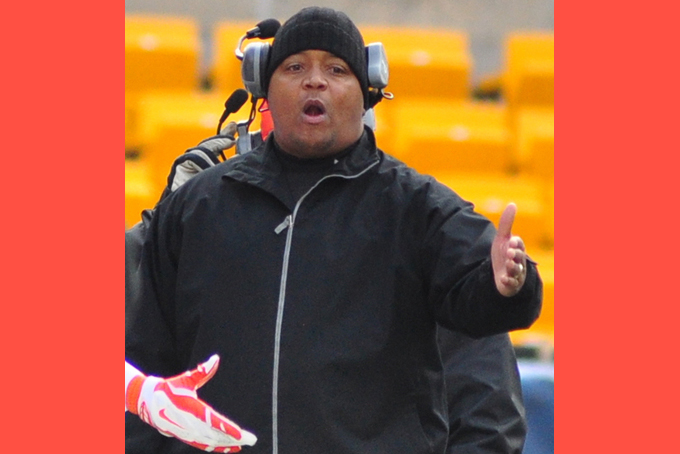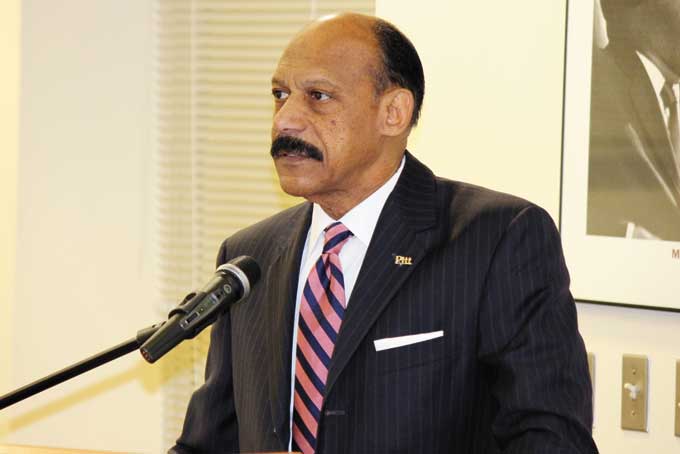
First of two parts.
PITTSBURGH (AP) – Before the start of every high school football season, Stacy Robinson goes through a familiar routine.
The head coach at Union High School for the past 18 seasons, Robinson makes it a point to keep an eye on fellow African-Americans trying to break into the head coaching ranks, those going through the same things he did nearly two decades ago.
Robinson believes it’s his responsibility to reach out to these coaches coming along and help them in any small way he can.
Though it’s something he continues to do, the regimen often has a familiar ending, with very few African-Americans getting hired in what can be a bleak landscape for coaches of their race.
“It’s not a surprise to me that this has been going on,” Robinson said.
In a city where the most high-profile coaching figure is an African-American – Mike Tomlin of the Steelers – and in a region that gave birth to the Rooney Rule, which requires NFL teams to interview at least one minority candidate for a head-coaching vacancy, the local pool of high school football coaches is thin on diversity.
In the 2014 season, only 9 of 130 area high schools employed a head coach who is a racial minority (6.9 percent), a number that is significantly lower than in other cities in the region.

It’s a figure former Gateway head coach and current Penn State cornerbacks coach Terry Smith called “embarrassing.” Dr. Richard Lapchick, a University of Central Florida academic who is considered a leading voice for racial issues in sports, said this lack of coaching diversity in high school football is a national problem, but referred to the numbers in Pittsburgh as “stunningly low” and “almost off-the-charts bad.”
Though few consider that overall lack of representation intentional, it nonetheless exists, impacting the lives of the men who find a calling in the sport they love.
“I think it goes unnoticed,” Clairton coach Wayne Wade said. “It’s just been the norm for so long. I wouldn’t say it has anything to do with race or nepotism. It’s just the opportunities aren’t there.”
Familiar quandary
As startling as some view that 6.9 percent figure, it’s part of a much larger picture that paints a unique situation in western Pennsylvania, at least in relation to large cities in the Midwest with a similar demographic base.
In the Cincinnati metropolitan area, where minorities comprise 15.3 percent of the population, compared to 11.2 percent in Pittsburgh, 13.3 percent of high school football head coaches are minorities, nearly double what it is in the WPIAL and City League. In the Columbus, Ohio area, it’s also 13.3 percent. In Indianapolis, it’s 12.9 percent. In Louisville, Ky., which has a minority population of 16.5 percent, it’s 17.9 percent.
Perhaps the most glaring aspect of Pittsburgh’s low minority coaching numbers is that there isn’t a dearth of potential candidates.
A Pittsburgh Post-Gazette survey of local high schools found that 19.2 percent of assistant coaches in the WPIAL and City League are racial minorities. That percentage suggests there are a number of qualified applicants out there who, for one reason or another, aren’t getting hired as head coaches, stuck in the same kind of quandary Wade and Robinson were for many years.
Not only is the percentage of minority head coaches disproportionate to the number of minority assistants in the area, it’s not representative of the players they coach.
The data on assistant coaches is on par with the 18.2 percent of students at 120 area public high schools who are racial minorities, according to Pennsylvania Department of Education records from the 2013-14 academic year. The WPIAL does not keep track of the racial composition of its athletes.
To those who study the role of race in society, there’s a disparity between these different sets of statistics that produces a lucid conclusion.

“Clearly, there’s a bias of some sort going on,” said Dr. Larry Davis, the director of Pitt’s Center on Race & Social Problems. “That goes without saying, to have a number of assistant coaches and not many head coaches. Something’s clearly going on.”
Numbers game
Any question as to why there are so few minority head football coaches in western Pennsylvania does not come with a simple answer, something one might expect for a complex, multi-tiered issue.
Some point to the shrinking of the City League, which has gone from 10 teams in 2003 to six. Three of the area’s nine minority head coaches are at schools in the Pittsburgh Public Schools system.
In an area where more than a few coaches have been in their current role for decades, others bemoan the lack of opportunities for head coaching positions, be it for white or non-white candidates. Even when these long-tenured coaches retire or take jobs elsewhere, one of their assistants often succeeds them, significantly reducing the pool of potential replacements.
There’s also the matter of local school systems and their distinct structure. As opposed to being united under one governing body, the 120 local public high schools are divvied up into 113 school districts. That number of entities could mean that things such as the racial makeup of coaches simply end up going unnoticed.
It could even tie back to the very nature of high school sports.
Unlike the professional and college ranks -where coaches are hired based entirely on their merits for full-time positions – coaching searches in high school football are not so cut and dried.
The PIAA, the state’s governing body for high school athletics, has a laundry list of requirements a coach must fulfill, such as courses on concussion and cardiac arrest protocol, first aid and coaching fundamentals.
Those coaching prerequisites, however, are not exclusive to Pennsylvania. High school athletic associations in Ohio and Kentucky, for instance, have a similarly lengthy list of guidelines for prospective coaches.
The idea remains, though, that these positions are labors of love, jobs that are incredibly time-intensive with little financial incentive. (Many coaches don’t make more than a few thousand dollars per year.) In short, it takes a certain kind of person to want to coach high school football.
“There are so many variables that go into coaching at the high school level that I don’t think that race or gender or anything like that factors into it,” WPIAL executive director Tim O’Malley said. “If you recently research what the PIAA requires for anybody to become involved in coaching at the interscholastic level, why anybody wants to coach today is beyond me.”
There’s also an educational component.
It’s advantageous to hire a coach who works at the school or in the district, as it allows them to be close to their players and be a more constant presence in their lives beyond practices and games.
Some like Robinson wonder if that plays a role.
“If you look at minority head coaches, there’s probably not as many minority teachers, especially male teachers,” he said. “Right away, that limits the opportunities for us.”
As limiting as those factors can be, they theoretically apply to any coaching hopeful, regardless of their skin color. So while those facts provide context, they don’t offer a full explanation.
To some, that 6.9 percent figure and how it compares to similar cities says much more than any possible reason for its existence could.
“People are always looking for excuses, but the reality is that if you want to get a coach of color at the high school level, there are coaches of color available who have the experience and skill set that will be exactly what you’re looking for if you’re open to it,” Lapchick said. “That wouldn’t be true if you’re trying to do it at every school, but certainly at more than 6.9 percent of the schools.”
